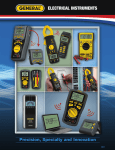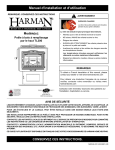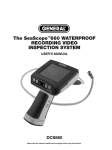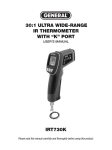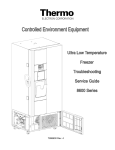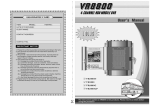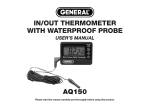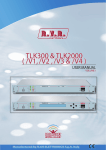Download GT310 - General Tools And Instruments
Transcript
WIRELESS DATA LOGGING MULTIMETER WITH DUAL 7-SEGMENT LCD PLUS NCVD/NCCD USER’S MANUAL (laptop not included) GT310 (optional RD330 not included) Please read this manual carefully and thoroughly before using this product. TABLE OF CONTENTS Introduction. . . . . . . . . . . . . . . . . . . . . . . . . . . . . . . . . . . . . . . . 3 – 4 Key Features & Specs . . . . . . . . . . . . . . . . . . . . . . . . . . . . . . . . . . . 5 What’s in the Box . . . . . . . . . . . . . . . . . . . . . . . . . . . . . . . . . . . . . . 6 Safety Instructions . . . . . . . . . . . . . . . . . . . . . . . . . . . . . . . . . . 6 – 8 Product Overview . . . . . . . . . . . . . . . . . . . . . . . . . . . . . . . . . . 8 – 11 Setup Instructions. . . . . . . . . . . . . . . . . . . . . . . . . . . . . . . . . . . . . 11 Install Battery . . . . . . . . . . . . . . . . . . . . . . . . . . . . . . . . . . . . 11 Insert Test Leads . . . . . . . . . . . . . . . . . . . . . . . . . . . . . . . . . . 11 Operating Instructions . . . . . . . . . . . . . . . . . . . . . . . . . . . . . 12 – 19 General Instructions . . . . . . . . . . . . . . . . . . . . . . . . . . . . . . . 12 Measuring DC or AC Voltage . . . . . . . . . . . . . . . . . . . . . 12 – 13 Measuring Resistance or Capacitance . . . . . . . . . . . . . . . . . 13 Checking the Integrity of a Diode or the . . . . . . . . . . . . . . . . 14 Continuity of a Circuit Measuring DC or AC Current . . . . . . . . . . . . . . . . . . . . . 14 – 15 Non-Contact AC Voltage/Current Detection (NCVD/NCCD) . . . 15 Going Wireless. . . . . . . . . . . . . . . . . . . . . . . . . . . . . . . . 16 – 19 Transmitting Data to a PC . . . . . . . . . . . . . . . . . 16 – 18 Receiving and Displaying Data from a Second GT310 or a GT320. . . . . . . . . . . . . . . . . 18 – 19 Specifications . . . . . . . . . . . . . . . . . . . . . . . . . . . . . . . . . . . . 19 – 22 Maintenance Tips . . . . . . . . . . . . . . . . . . . . . . . . . . . . . . . . . . . . . 22 Optional Accessories and Replacement Parts . . . . . . . . . . . . . . . 22 Warranty Information . . . . . . . . . . . . . . . . . . . . . . . . . . . . . . . . . . 23 Return for Repair Policy . . . . . . . . . . . . . . . . . . . . . . . . . . . . . . . . 23 2 INTRODUCTION Thank you for purchasing General Tools & Instruments’ GT310 Wireless Data Logging Multimeter with Dual 7-Segment LCD plus NCVD/NCCD. Please read this manual carefully and thoroughly before using the instrument. The GT310 can measure—with better than 1% accuracy, in most cases—the six electrical parameters (DC voltage, AC voltage, DC current, AC current, resistance and capacitance) that most professional-grade multimeters measure. Like other multimeters, it can also be used to verify the integrity of a diode and to check for continuity within a circuit. However, the GT310 has two safety and convenience features—NCVD/NCCD and wireless device-to-device communication—that many comparably priced multimeters lack. NCVD and NCCD—non-contact voltage and current detection— empower the electrician in several valuable ways. For example, the meter’s integrated NCVD sensor can quickly determine which wire in a group is “live” without the user having to “tap” all the lines. It is so sensitive it can pinpoint the location of a 30VAC line inside PVC conduit behind a wooden wall. The NCCD sensor in the GT310 is equally impressive. It can detect as little as 500 mA of current flowing behind a concrete or plaster wall, under a floor, above a ceiling, in an overhead line, or in a buried underground cable. The NCCD sensor can also detect RF signals (such as from a walkie-talkie) and magnetic fields. Wireless communication offers an additional level of safety and convenience. Being able to read the meter’s measurements from up to 33 ft. (10m) away (on a PC, on a second multimeter in the GT Series, or on the optional RD330 Remote Display with Memory) lets the electrician observe the effect of throwing a switch or changing a setting on a piece of equipment without having to be near it. If a system or piece of equipment operates at high voltages, remote display makes troubleshooting it safer. If multiple changes to another system or piece of equipment are needed to troubleshoot a problem, remote display may save an electrician considerable time by allowing him or her to immediately see the results of each step taken without having to shuttle between two areas. 3 The GT310 can be part of three different kinds of wireless communication schemes. 1. The meter includes a small USB receiver—called a dongle—that enables any PC to display all the information shown on the unit’s display. The “Going Wireless” section of this user’s manual provides instructions for downloading the software needed to activate this connection. The advantage of using a PC’s monitor to display the meter’s measurements is readability: readings sent to the screen of a laptop or desktop computer are several inches high—large enough to be visible across a room. 2. With two GT310s or one GT310 and one GT320 (essentially, a GT310 with a dual dot-matrix display instead of a dual 7-segment display), each meter can be configured to display its own measurements on its upper readout, and receive and display the other meter’s measurements on its lower readout. Both models include the wireless transceiver module needed to “share” readings remotely—improving safety in the process—in this way. 3. For even greater remote display versatility, consider purchasing General’s RD330 Remote Display with Memory as an optional accessory. The standalone 4 in. x 4 in. unit, which uses the same wireless transceiver module as the GT310 and GT320, can not only display the readings of two multimeters simultaneously on its own dual LCD with 0.67 in. (17mm) high digits; it can also memorize up to 99 readings or pairs of readings. In addition to its memory, the advantages of using the RD330 as a remote GT310 display are compactness and portability. Another key feature of the GT310 is its pair of double-insulated fused test leads. Like NCVD/NCCD and wireless device-to-device communication, the fuse in the red test lead offers the electrician safety and convenience. It not only prevents excessive currents from flowing through the meter, potentially injuring the user and damaging the meter. In addition, the position of the fuse makes changing it fast and easy. In many other multimeters, changing a blown fuse requires the user to open up the instrument. The red lead has a unique square plug. The meter’s use of a square (+) jack prevents potentially damaging use of industry-standard round, non-fused leads. 4 KEY FEATURES & SPECS • 12 functions, 33 ranges • Measures AC/DC voltage (up to 750VAC/1000VDC), AC/DC current (up to 400mA), resistance (up to 40mΩ) and capacitance (up to 100 uF) • Verifies integrity of diodes and checks circuits for continuity • Includes double-insulated test leads; red lead has fast-acting ceramic fuse rated at 500mA/500V and unique square plug. Corresponding square jack on meter prevents potentially damaging use of round, non-fused leads. • Includes non-contact AC voltage and current detection (NCVD and NCCD) sensors with beeper • CAT III 1000V, CAT IV 500V certified • Wirelessly interfaces to PC at 2.4 GHz from up to 33 ft. (10m) away via included USB dongle • Includes transceiver module for wirelessly interfacing to second GT310 or GT320 (functionally identical model with dot-matrix display) or optional RD330 Remote Display with Memory • Choice of 10 channels for each wireless link • Two-line, 3-3/4 digit (4000 count), 7-segment LCD with 0.67 in. (17mm) high digits on upper readout • Auto ranging or manual ranging • Data hold and zero adjust buttons • Fifteen-minute Auto Power Off function • Low battery indicator • Ergonomic design with rugged rubber housing 5 WHAT’S IN THE BOX The GT310 comes in a black soft pouch inside a box. Also inside the box are: • A pair of fused test leads (General Part No. TL300) • A USB dongle (General Part No. GTSF05) for wireless viewing of the meter’s display on a PC. Software for enabling the dongle to display the GT310’s readings on a PC is downloadable from the GT310 page of General’s website. • A “9V” battery • This user’s manual SAFETY INSTRUCTIONS !WARNING To avoid possible electric shock or personal injury, and to avoid damaging the meter or the equipment under test: • Do not use the meter in any way not detailed in this manual or the meter's safety features may be compromised. • Before using the meter, inspect the case. Do not use the meter if it is damaged. Look for cracks or missing plastic. Pay particular attention to the insulation around the connectors. • !WARNING Inspect the test leads for damaged insulation or exposed metal. Check the test leads for continuity. Replace damaged test leads before using the meter. • For safety reasons, you cannot switch to using unfused test leads to make measurements. YOU MUST USE FUSED TEST LEADS fitted with a fast blow fuse rated at 500mA/500V. Using unfused test leads also voids the limited warranty. • Verify the meter’s operation by measuring a known voltage. Do not use the meter if it operates abnormally. Protection may be impaired. When in doubt, have the meter serviced. • !WARNING Do not apply more than the rated voltage, as marked on the meter, between the terminals or between any terminal and ground. 6 • !WARNING Do not measure voltages above 500V in CAT III installations. • !WARNING Do not measure voltage with the rotary dial pointing to the resistance (ohms), current, capacitance or NCVD or NCCD positions. Never measure current with the dial pointing to the resistance (ohms), capacitance or NCVD or NCCD positions. • Use caution when working with voltages above 42V ACrms, or 60V DC. These voltages pose a shock hazard. • Use the proper terminals, function, and range for all measurements. • !WARNING Do not operate the meter around explosive gas, vapor, or dust. • !WARNING When using the probes, keep your fingers behind the finger guards. Do not touch the metal probes of the test leads when making a measurement. • When making connections, connect the black (–) test lead before connecting the red (+) test lead; when disconnecting, disconnect the red (+) test lead before disconnecting the black (–) test lead. • Disconnect circuit power and discharge all high-voltage capacitors before measuring/testing resistance, continuity, diodes, or capacitance. • For all DC functions in both auto ranging and manual ranging modes, to avoid the risk of shock due to possible improper reading verify the presence of any AC voltages by first using the AC voltage measurement function. Then select a DC voltage range equal to or greater than the AC range. • Before measuring current, turn off power to the circuit before connecting the meter. • Do not operate the meter with the case (or part of the case) removed. • Replace the battery as soon as the low battery indicator “ ” appears. Operated with a weak battery, the meter might produce false readings that could lead to electric shock and personal injury. • Remove the test leads from the meter before opening the meter case or battery compartment. 7 PRODUCT OVERVIEW Fig. 1 shows the labels and positions of the controls, indicators and connectors on the front and top of the GT310. Familiarize yourself with their functions, as explained below, before moving on to the Setup Instructions and Operating Instructions. GT310 Fig. 1. The GT310’s controls, indicators and connectors 1. Replaceable 2.4GHz transceiver module (on top of unit) 2. NCCD sensor (on top of unit) 3. NCVD sensor (on top of unit) 4. Two-line, 7-segment LCD 5. Flashing red/green indicator of operation in NCVD/NCCD mode 8 6. Two-function Range button: a) In all measurement modes, press briefly to exit Auto ranging mode (default) and enter Manual Ranging mode. With two exceptions (the highest voltage ranges), each subsequent brief press of the button decreases the measurement sensitivity (increases the full-scale measurement range) by a factor of 10 (one decimal place) b) In all measurement modes, press and hold for >3 seconds to exit Manual Ranging mode and enable Auto ranging 7. Multi-function Power/Tx/Rx/Ax button: appears at a) Press briefly to enable transmission (Tx) mode; upper right of display b) Press briefly a second time to enable reception (Rx) mode; appears at upper right c) Press briefly a third time to enable transmission and reception (Ax mode); both icons appear d) Press briefly a fourth time to disable transmission and reception (both icons disappear) e) With rotary dial in any position but OFF, press and hold for >3 seconds to power meter on or off. 8. Adj. Zero button (press briefly to reset readout) 9. Two-function Buzzer button: a) Press briefly to turn backlight on/off b) Press and hold for 3> seconds to turn beeper on/off ( appears/disappears at right of display) 10. Multi-function Select/0-9 button: a) In voltage and current measurement modes, press briefly to switch from DC measurement (default) to AC measurement b) With rotary dial set to position, press briefly to switch from resistance measurement mode (the default) to diode integrity check mode. Press briefly again to switch to continuity check mode. Press briefly again to switch to capacitance measurement mode. Press briefly again to return to resistance measurement mode 9 c) In channel entry mode (with channel number flashing in top or bottom readout), press briefly to increment channel number. Pressing the button briefly with the display showing CH-9 resets readout to CH-0 11. Two-function Hold/CH button: a) Press briefly to hold (freeze) reading(s). Press briefly again to release hold. b) Press and hold for >3 seconds to enter Hi channel entry mode. In Hi channel entry mode, press briefly to enter Lo channel entry mode. In both modes, if no entry is made within 10 seconds, readout(s) revert to showing real-time measurements. 12. Rotary dial 13. COM jack for black (negative) test lead 14. Jack for red (positive) test lead 15. Battery compartment (on back of unit) 16. Black (negative) test lead 17. Red (positive) test lead. Contains fast-acting ceramic fuse rated at 500mA/500V 18. Protective caps for test leads The table below explains the symbols and abbreviations used on the meter and in this manual. Electrical Symbols Used On the Meter and In This Manual Adjust reading to zero Wireless transmit mode Wireless receive mode Alternating voltage / current Direct voltage / current Negative Freeze / Hold reading Wireless Transmit / Receive (Tx/Rx) channel 0-9 10 Diode Auto ranging Low battery Overvoltage Category 3 Overvoltage Category 4 Ground Beeper Non-Contact Voltage (AC) Detection Non-Contact Current (AC) Detection SETUP INSTRUCTIONS INSTALL BATTERY The battery of your GT310 may or may not already be installed. If the display remains dark after you turn the rotary dial to any position other than OFF: • Return the rotary dial to the OFF position. • Disconnect test leads. • Flip the meter over and lift the bottom of the yellow foldaway stand on the back with your fingertip or a flat-blade screwdriver. • Loosen and remove the two Phillips-head screws securing the rectangular yellow plastic battery compartment cover. Set the cover aside. • Install a fresh “9V” battery in the compartment, with the (+) terminal (anode) on the right (with the back of the meter facing you). • Replace the battery compartment cover and resecure it with the two screws. INSERT TEST LEADS Plug the red (fused) test lead into the right (red) socket on the front of the meter and plug the black lead into the black socket. Remove the clear plastic caps from the tips of the leads. 11 OPERATING INSTRUCTIONS GENERAL INSTRUCTIONS • To hold (freeze) a reading, briefly press the Hold/CH button. • To turn the beeper on or off, press and hold the Buzzer button. • To turn the backlight on or off, briefly press the Buzzer button. • The meter is equipped with an Auto Power Off (APO) function that is triggered by 15 minutes with no input. It cannot be disabled. To “wake up” the meter in the same measurement state (but not transmission/reception state) it was in when the APO function activated, briefly press the Power/Tx/Rx/Ax button (Callout 7 of Fig. 1). You need not turn the rotary dial to power the meter on again. • Each time you finish using the meter, turn the rotary dial to the OFF position. • To ensure the accuracy of measurements, make sure that the points touched by the test probes are free from dirt, oil, lacquer, and similar substances. • Until you configure the meter for wireless operation, only the upper readout will display measurements. In “normal” operating mode, the display will look like this: MEASURING DC OR AC VOLTAGE F! Do not exceed maximum ratings. Do not contact circuits or parts of circuits in which voltages with amplitudes greater than 25V ACrms or 35VDC may be present. Turn the rotary dial to the V position. The unit mV will appear at the right of the display. The symbol will appear at the top left of the display, below the word AUTO, indicating that the meter is ready to measure DC voltage in Auto ranging mode. To measure AC voltage, briefly press the Select/0-9 button to change the symbol to ~. 12 Touch the test leads to two points in a circuit at different electric potential. A minus sign (–) at the left of the reading indicates a negative voltage. To switch to Manual Ranging mode, press the Range button briefly once to remove the AUTO indication from the top left of the display. With two exceptions (the highest ranges), each subsequent brief press of the button decreases the measurement sensitivity (increases the full-scale measurement range) by a factor of 10 (one decimal place). If the measured voltage is greater than the full-scale range, the readout will be OL. To return to Auto ranging mode, press and hold the Range button. In AC or DC voltage measurement mode, the meter presents an input impedance of >10MΩ to the circuit under test. MEASURING RESISTANCE OR CAPACITANCE Before measuring resistance or capacitance, be sure to remove power from the circuit under test and to discharge any high-voltage capacitors in it. Turn the rotary dial to the Ω position. The unit MΩ will appear at the right of the display. The word AUTO will appear at the top left, indicating that the meter is in Autoranging mode. To measure the resistance between two points of a circuit, touch the test leads to those two points. To measure the capacitance between two points of a circuit, press the Select/0-9 button briefly three times to change the MΩ symbol to the letter F. Then touch the test leads to the two points of interest. To switch to Manual Ranging mode, press the Range button briefly once to remove the AUTO indication from the top left of the display. Each subsequent brief press of the button decreases the measurement sensitivity (increases the full-scale measurement range) by a factor of 10 (one decimal place). 13 CHECKING THE INTEGRITY OF A DIODE OR THE CONTINUITY OF A CIRCUIT Before checking a diode or checking for continuity, be sure to remove power from the circuit under test. Turn the rotary dial to the Ω position. With the symbol MΩ at the right of the display, briefly press the Select/0-9 button once to call up the diode symbol . Connect the red test lead to the anode (positive terminal) of the diode to be tested, and the black test lead to its cathode (negative terminal). Read the forward bias voltage value on the display. A typical silicon diode has a forward bias voltage between 0.7 and 0.99V. A typical germanium diode has a forward bias voltage between 0.3 and 0.36V. A 0V reading in both directions indicates a shorted diode. An OL reading indicates an open diode. In either case, the diode is defective and should be replaced. An OL reading also may indicate that the polarity of the test leads is reversed. This test can be used to distinguish the anode and cathode of a diode. To enter Continuity Check mode, briefly press the Select/0-9 button once with the diode symbol showing on the display. This will change the diode symbol to the Ω unit. If the icon is not visible at the right of the display, activate the beeper by pressing the Buzzer button. In Continuity Check mode, the initial reading will be OL. Touch the test leads to any two points in the circuit. If the resistance between the points is <30 Ω, the meter will produce a long beep. MEASURING DC OR AC CURRENT F! The circuit to be tested may not carry a voltage in excess of 1000VDC or 750VAC. Applying a current of >500 mA will blow the fuse in the red test lead. To remove the fuse, unscrew the top of the red lead. Replace the blown fuse with a fast-acting ceramic fuse with a rating of 500mA/500V. Turn the rotary dial to the uA or mA position, depending on the expected amplitude. The unit uA or mA will appear at the right of the display. The word AUTO will appear at the top left, indicating that the meter is in Auto ranging mode. 14 The default mode is DC current measurement (indicated by the symbol near the top left of the display). To measure AC current, press symbol to ~. the Select/0-9 button to change the Touch the test leads to two points in the circuit and read the displayed value. A minus sign (-) at the left of the reading indicates a negative value in DC current mode. If applying current produces a reading of OL in uA Measurement mode, switch to mA Measurement mode. To switch to Manual Ranging mode, briefly press the Range button once to remove the AUTO indication from the top left of the display. Each subsequent press of the Range button decreases the measurement sensitivity (increases the full-scale measurement range) by a factor of 10 (one decimal place). If the measured current amplitude is greater than the full-scale range, the display will show OL. To return to Auto ranging mode, press and hold the Range button. NON-CONTACT AC VOLTAGE/CURRENT DETECTION (NCVD/NCCD) Turn the rotary dial to the NCVD or NCCD position. Move the meter at least several feet away from all wiring and briefly press the Adj. Zero button. This maximizes the sensitivity of the NCVD or NCCD sensor. Holding the meter in your hand, slowly move its top toward the known or suspected source of voltage or current. As the meter approaches the potential source of AC voltage or current, the display reading will increase, the beeper will increase its speed, and a light (red for voltage, green for current) behind the left side of display will flash faster. The display reading is a relative value with no units. When the reading peaks, briefly press the Hold button to freeze it. To use the meter to distinguish a true “live” wire from a “ghost” live wire, turn the rotary dial to the NCVD position, move the meter away from all wiring, and press the Adj. Zero button. Plug the red test lead into the red front-panel socket. Touch the tip of the lead to the suspected live wire and note the display reading. Also touch other suspected sources. The true live wire will produce the highest reading. 15 GOING WIRELESS Transmitting Data to a PC Use the following procedure to enable your GT310 to display its readings on a PC monitor using digits that are several inches high— large enough to be visible across a room. You will first download and install the software that enables your GT310 to communicate with the GTSF05 wireless USB receiver (dongle) supplied with the meter. The final few steps of the procedure explain how to match the software’s receiving channel to the transmitting channel of the GT310. 1. Go to www.generaltools.com and enter GT310 in the SEARCH box. 2. On the GT310 page, click the “Download General Tools Product Software” button. 3. Save <GTSF05_Setup.zip> to your desktop. 4. Click the Open button on the icon. 5. Highlight <GTSF05_Setup.msi> 6. Use a utility like WinRAR to extract <GTSF05_Setup.msi> to your desktop. 7. Double-click <GTSF05_Setup.msi>; doing so opens a window titled “Welcome to the DMMD_PCViewSetupWizard”. Click Next. 8. Click Next to install <DMMD_PCView> on your computer in a folder named <C:\ProgramFiles(x86)\DMMD_PCView\>. To install the program elsewhere, click Browse and choose an alternate location. 9. The next window confirms the installation. Click Next to continue. 10. The next window is titled <Installing DMMD_PCView>. Installation typically takes less than 1 minute. 11. Click Close to exit. 12. Note that a GTSF05.exe icon has been added to your PC’s desktop and Start button. 13. Double-click the icon to open the program. 14. A “Tips” window will appear asking you to “Please insert GTSF05 dongle!” 16 15. Plug the dongle into any open USB port on your computer. Doing so will cause the following screen to appear. 16. On the meter, press the Power/Tx/Rx/Ax button once. The icon will appear at right. You will next choose CH-1 as the meter’s transmitting channel. To do so, press and hold the Hold/CH button. When a flashing “0” (the default channel number) appears at the right of CH- on the upper readout, quickly (within 10 seconds) press the Select/0-9 button once to advance the channel counter to “1”. Quickly save the setting by pressing and holding the Hold/CH button. 17. On the “DMMD_PCView GTSF05” screen, click the Scan CH button. The program will begin scanning Channels 0 through 9. Scanning will stop when the GT310’s transmission on Channel 1 is detected, causing the � button to turn green. 18. Click again on the green � button to produce a display like the following: 17 19. The reading on the DMMD_PCView screen will continue to duplicate the contents of the GT310’s upper readout. Receiving and Displaying Data from a Second GT310 or a GT320 To configure your GT310 to receive display measurements and indications from another GT310 or a GT320 wireless multimeter, use the Power/Tx/Rx/Ax button. When the meter is powered on, the default setting is no communication. To enable transmission, briefly press the Power/Tx/Rx/Ax button once. A icon will appear at the right of the upper readout and the display will look like this: To enable reception, briefly press the Power/Tx/Rx/Ax button a second time. The icon will disappear and a will appear at the right of the lower readout. In “receive only” mode, your GT310 will not display any of its own measurements on the upper readout; it will only display, on its lower readout, measurements from a second wireless multimeter. Immediately after you enable receive mode, your GT310 will operate in “standby receive mode” until you synchronize its receiving channel with the transmitting channel of the other meter. Before you synchronize the two meters, the display will look like this: After you synchronize the two multimeters, the new display will duplicate the data shown on the second meter and look like this: To match the receiving channel of your GT310 to the transmitting channel of the second multimeter, press and hold the Hold/CH button, and then press it briefly to cause the lower readout to show CH-0. Quickly (within 10 seconds), press the Select/0-9 button as many times as needed until the channel number on the lower readout matches the transmitting channel number of the second multimeter. 18 To enable transmission and reception, briefly press the Power/Tx/Rx/Ax button a third time. This will cause both “satellite dish” icons to appear at the right of the display. The upper readout will display data from your GT310 and the lower readout will display data from the second multimeter. The composite display will look like this: SPECIFICATIONS GENERAL SPECIFICATIONS • Maximum Voltage between Terminal and Ground: CAT III 1000V, CAT IV 500V • Test Leads Characteristics: Double sheath, soft PVC wire fitted with 500mA/500V fast-acting ceramic fuse measuring 6mm across x 32mm long. Red lead also has unique square plug compatible with (+) jack on meter. • Display Type: Two-line, 3-3/4 digit (4000 count), 7-segment LCD with 0.67 in. (17mm) high digits on the upper readout • Sampling Rate: 3 times 1 sec. • Maximum Voltage Measurement: DC 1kV , AC 750V • Input Impedance in Voltage Measurement Mode: >10MΩ • Maximum AC/DC Current Measurement: 400mA • Maximum Resistance Measurement: 40MΩ • Maximum Capacitance measurement: 100uF • Diode Integrity Test Voltage: 1.5V • Continuity Check Threshold: <30Ω with beeper • Non-contact AC Voltage Detection Range: 50V to 1 kV or higher; 100 to 250V in “Live or Ghost” mode • Non-contact AC Current Detection Range: 100mA to 1000A or higher • Transmission/Reception: Half-duplex; Ten channels centered on 2.4GHz 19 • Communication Range: >33 ft. (10m) • Auto Power Off Interval: 15 minutes • Backlight Fadeout Interval: 90 seconds • Power Source: (1) “9V” battery • Power Consumption: <3mA (standby mode); <20mA (normal operating mode); <25mA (transmitting mode); <60mA (receiving mode); <80mA (transmit + receive mode) • Dimensions (Excluding Test Leads): 7.1 x 3.7 x 2.1 in. (180 x 95 x 54mm) • Weight (Excluding Battery): 1 lb. (450g) MEASUREMENT RANGES, RESOLUTIONS & ACCURACIES AC Voltage (Manual Range) Range 0-400mV 0-4V 0-40V 0-400V 0-750V Resolution 0.1mV 0.001V 0.01V 0.1V 1V Accuracy ±0.6% of reading ±3 digits ±0.6% of reading ±3 digits ±0.6% of reading ±3 digits ±0.6% of reading ±3 digits ±1.0% of reading ±5 digits DC Voltage (Manual Range) Range 0-400mV 0-4V 0-40V Resolution 0.1mV 0.001V 0.01V Accuracy ±0.6% of reading ±2 digits ±0.6% of reading ±2 digits ±0.6% of reading ±2 digits 0-400V 0-1000V 0.1V 1V ±0.6% of reading ±2 digits ±0.8% of reading ±2 digits AC Current (uA Setting, Manual Range) Range 0-400uA 0-4mA 20 Resolution 0.1uA 1uA Accuracy ±0.15% of reading ±5 digits ±0.15% of reading ±5 digits DC Current (uA Setting, Manual Range) Range 0-400uA 0-4000uA Resolution 0.1uA 1uA Accuracy ±0.12% of reading ±3 digits ±0.12% of reading ±3 digits AC Current (mA Setting, Manual Range Range 0-40mA 0-400mA Resolution 0.01mA 0.1mA Accuracy ±0.15% of reading ±5 digits ±0.15% of reading ±5 digits DC Current (mA Setting, Manual Range) Range 0-40mA 0-400mA Resolution 0.01mA 0.1mA Accuracy ±0.15% of reading ±5 digits ±0.15% of reading ±5 digits Resistance (Manual Range) Range 0-400Ω Resolution 0.1Ω Accuracy ±0.7% of reading ±5 digits 0-4kΩ 0-40kΩ 0-400kΩ 0-4MΩ 0-40MΩ 0.001kΩ 0.01kΩ 0.1kΩ 0.001MΩ 0.01MΩ ±0.6% of reading ±2 digits ±0.6% of reading ±2 digits ±0.7% of reading ±2 digits ±1.5% of reading ±5 digits ±2.0% of reading ±6 digits Capacitance (Manual Range) Range 0-52nF 0-520nF 0-5.2uF 0-52uF 0-100uF Resolution 0.01nF 0.1nF 0.001uF 0.1uF 0.1uF Accuracy ±3% of reading ±7 digits ±3% of reading ±5 digits ±3% of reading ±5 digits ±10% of reading ±10 digits ±10% of reading ±10 digits Diode Integrity Check Range 1.5V Open Resolution 0.001V Accuracy ±10% of reading ±5 digits 21 Continuity Check Range 400Ω (Display reading) Beeper sounds when<30Ω Resolution 0.0Ω 0.0Ω Accuracy ±0.8% of reading ±6 digits ±0.8% of reading ±6 digits Non-Contact AC Voltage Detection Range 0000 (signal strength) Buzzer speeds up and red backlight flashes when signal strength >0010 Resolution 1 count 1 count Non-Contact AC Current Detection Range 0000 (signal strength) Buzzer speeds up and green backlight flashes when signal strength >0010 Resolution 1 count 1 count MAINTENANCE TIPS The GT310 is not waterproof or water-resistant; avoid water, toxic environments and temperature extremes. Do not turn on the meter immediately after it has been taken from a cold to a warm environment. The condensation that may result could destroy the unit. Leave the meter switched off and wait until it reaches room temperature. Remove the battery when you do not expect to use the unit for a long period of time (several months). Clean the display by wiping it with a damp soft cloth. Never use solvents or abrasives. OPTIONAL ACCESSORIES AND REPLACEMENT PARTS • Replacement GTSF05 Wireless USB Receiver (dongle) • Optional RD330 Remote Display with Memory • Replacement TL300 Fused Test Leads 22 WARRANTY INFORMATION General Tools & Instruments’ (General’s) GT310 Wireless Data Logging Multimeter with Dual 7-Segment LCD plus NCVD/NCCD is warranted to the original purchaser to be free from defects in material and workmanship for a period of one year. Subject to certain restrictions, General will repair or replace this product if, after examination, the company determines it to be defective in material or workmanship. This warranty does not apply to damages that General determines to be from an attempted repair by non-authorized personnel or misuse, alterations, normal wear and tear, or accidental damage. The defective unit must be returned to General Tools & Instruments or to a Generalauthorized service center, freight prepaid and insured. Acceptance of the exclusive repair and replacement remedies described herein is a condition of the contract for purchase of this product. In no event shall General be liable for any incidental, special, consequential or punitive damages, or for any cost, attorneys’ fees, expenses, or losses alleged to be a consequence of any damage due to failure of, or defect in any product including, but not limited to, any claims for loss of profits. RETURN FOR REPAIR POLICY Every effort has been made to provide you with a reliable product of superior quality. However, in the event your instrument requires repair, please contact our Customer Service to obtain an RGA (Return Goods Authorization) number before forwarding the unit via prepaid freight to the attention of our Service Center at this address: General Tools & Instruments 80 White Street New York, NY 10013 212-431-6100 23 GENERAL TOOLS & INSTRUMENTS 80 White Street New York, NY 10013-3567 PHONE (212) 431-6100 FAX (212) 431-6499 TOLL FREE (800) 697-8665 e-mail: [email protected] www.generaltools.com GT310 User’s Manual Specifications subject to change without notice ©2012 GENERAL TOOLS & INSTRUMENTS NOTICE - WE ARE NOT RESPONSIBLE FOR TYPOGRAPHICAL ERRORS. MAN#GT310 7/12/12

























